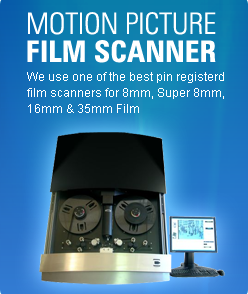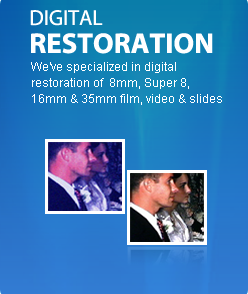
Transfer Types
On this page you'll learn about the different types of film transfers. In addition, there is a film transfer basics section at the bottom of this page that will help you understand how the different film transfer types compare to each other.
Real Time
Today, over 80% of the film transfer companies use a real-time transfer process. Most real-time transfers use a modified projector with a standard definition camera or camcorder. You could even setup a crude real-time transfer system at home using your projector and a camcorder. As you can imagine, using a camcorder to record the film is not the best method. In fact, you loose about 40% to 50% of the quality during a real-time transfer. Some companies use a high definition camera or camcorder instead. It might make it look 5% to 10% better. The problem isn't the camcorder but the transfer method, meaning that the camcorder is recording the film as it plays as opposed to scanning the film (see below). Today, the bigger issue is the damage that will happen to your film running it through a real time system. Film shrinks over time and so the sprocket holes are about 1mm closer then they used to be. Running the film through a real time or frame by frame machine (below) will damage the film.
Standard Definition Camera/Camcorder: Average 15 cents/ft
High Definition Camera/Camcorder: Average 22 cents/ft
Frame by Frame
In a frame by frame process, the camera/camcorder and projector are still used for capture but it is used in a different way than it was used in a real-time process. Each time a frame gets into the gate it sends a sync signal to the computer to capture the frame. So, the camcorder is used to take a picture of each frame instead of capturing a running video. Because you captured each film frame like a still picture, the video will come out with more detail than it would from a real-time process. A frame by frame process will result in video that is 20-30% better than a similarly configured real-time process. Again, the bigger issue is the damage to the film from running it through a modified projector. Because film shrinks over time, a frame by frame machine will damge the film.
Standard Definition Camcorder: Average 23 cents/ft
High Definition Camcorder: Average 29 cents/ft
Motion Picture Film Scanner
A professional motion picture film scanner is built with state of the art components made for the professional market. These machines use a roller based transport system instead of a sprocket based system. In addition, many of these scanners have some kind of automatic scan alignment to adjust for shrunk film. These technologies enable the scanner to deal with sprocket related problems and to ensure it can get 100% of the frame even on shrunken film.
The Rank Cintel machine was one of the best professional film scanners in the recent past. Some companies still use these machines. It was built in the 1980s to transfer 16mm/35mm film to standard definition video. The company never made a high definition version. Today, state of the art film scanners include DFT's Spirit and Scanity scanners. There are other companies building state of the art film scanners today as well. Using a professional motion picture film scanner will result in video that is 30-50% better than a similarly configured frame by frame process.
480 line per frame scan: Average 29 cents/ft
1080 line per frame scan: Average 39 cents/ft
DataCine Film Scanner
DataCine film scanners are used to archive everything from 8mm, Super 8, 16mm and 35mm film. These scanners scan at very high resolutions (2K, 4K) at a very slow rate compared to a motion picture film scanner. They scan in the range of a frame per second to a few frames per second. A DataCine is usually also pin registered. A pin registered scanner uses pins to stabalize the film prior to scanning. This ensures the most stable image during scanning.
DataCine film scanners include the Spirit 2K and 4K, Cintel's diTTo, and FilmLight's NorthLight scanners.
Using a professional DataCine film scanner will result in video that is 40-60% better at 2K/4K than a motion picture film scanner scanning at HD resolution for 16/35mm film.
2K scan: Average $0.80/ft
4K scan: Average $1.50/ft
Film Transfer Overview
Video has several characteristics that determine how good it is. One of the most important characteristics is the number of lines of resolution. The resolution determines how detailed and sharp the video is. If you’ve ever watched a standard definition video channel on an HDTV and then switched to the high definition (HD) version, you notice that the HD version is much sharper and detailed. The reason is that standard definition video has 480 horizontal lines while HD has 1080 lines. In a similar way, a film scan can deliver video in standard definition (480 lines), high definition (1080 lines) and 2K (1556 lines). Just like the TV channels, a high definition film transfer will look better than a standard definition film transfer.
Equally important as resolution is the type of film transfer. There are a few basic types of film transfer processes. More than 80% of the companies out there today use a real-time transfer. Any type of real-time film transfer will result in video that is 40-50% worse than the film’s current condition.
A frame by frame process means that each film frame is captured like a separate digital picture. Reading each frame one at a time increases the detail that is captured. A frame by frame process will result in video that is 20-30% better than a similarly configured real-time process.
The ultimate film transfer process uses a professional motion picture film scanner or DataCine film scanner. Instead of using a camcorder to capture the film, a scanner is used to scan the film. As you can image, scanning a photograph will give you much better quality than using your camcorder to video tape a photograph.
So, at this point you’ve learned that film transfers can capture at standard definition (480 lines), high definition (1080 lines) or 2K (1556 lines). You’ve also learned about the 3 different types of film transfers being used today. In order from least to best quality we have:
Without Restoration
- Real-Time Standard Definition (least quality)
- Real-Time High Definition
- Frame by Frame Standard Definition
- Motion Picture Film Scanner at 480 lines
- Frame by Frame High Definition
- Motion Picture Film Scanner at 1080 lines
- DataCine Film Scanner at 2K/4K (best quality)
The film transfer processes above are the basics types and do not include any restoration by themselves. Because over 90% of the old movie film we see needs restoration work, we've developed our Pro Hollywood Restoration that can remove 80% of the defects on the film.
With Restoration
- Real-Time Standard Definition - (least quality)
- Real-Time High Definition
- Frame by Frame Standard Definition - Our SD Scan
- Frame by Frame High Definition
- Motion Picture Film Scanner at 480 lines - Our Pro SD Scan
- Motion Picture Film Scanner at 480 lines with restoration
- Motion Picture Film Scanner at 1080 lines
- Motion Picture Film Scanner at 1080 lines with restoration - Our Pro HD Scan
- DataCine Film Scanner at 2k/4k
- DataCine Film Scanner at 2k/4k with restoration - Our Pro 2K Scan(best quality)





